|
Report from
Europe
European wooden furniture consumption fell 11% in
2023
The last four years, marked from the start of 2020 by the
Covid-19 pandemic and from February 2022 by war in
Ukraine, have seen unprecedented changes in Europe’s
wood furniture sector.
During this relatively short period, there have been major
alterations in patterns of supply and demand, trade flows,
consumer preferences and working conditions, distribution
channels, design, and fashion trends. Companies
throughout the sector are having to evolve new strategies
in response to a transformed world.
Europe’s wood furniture sector has passed through a
period characterised by an initial but very short-lived fall
in demand in the second quarter of 2020 during the first
Covid lockdown, followed by very rapid demand
escalation in 2021 with the onset of the home
improvement boom. This occurred at a time when material
shortages and other logistical challenges greatly reduced
availability.
The war in Ukraine and other geopolitical challenges then
drove a rapid escalation in energy prices, adding greatly to
the existing inflationary pressures. Rising interest rates
and declining consumer spending, after demand had been
satiated by high spending in the previous two years, then
led to a sharp decline in demand starting in the second half
of 2022 and continuing throughout 2023.
These trends are all evident in the changing value of
production, trade, and consumption of wood furniture in
the EU27+UK in recent years (Chart 1).
After the sharp upturn in the European market for wood
furniture in 2021, when large investments were made in
home improvement during the COVID pandemic,
production and consumption fell back respectively by 11%
and 12% in 2022.
Production and consumption then fell by another 8% and
11% respectively in 2023. In 2023, wood furniture
production in the EU27+UK was valued at €39.7 billion
while consumption was €39.4 billion. Other than in 2020,
when the market fell sharply at the height of the COVID
pandemic, such low levels had not been since 2014 when
Europe was emerging from the 2010-2012 Sovereign Debt
crises.
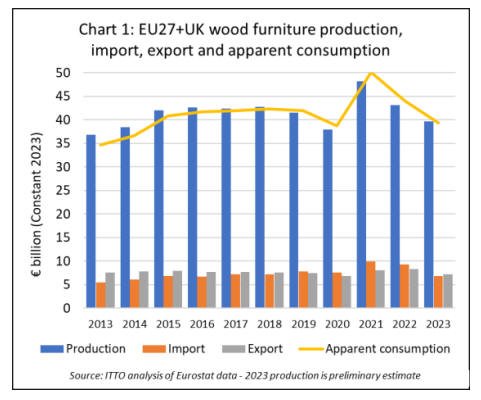
These figures underline the extent of the downturn in the
European economy. In 2023, Europe faced increased
uncertainty, sluggish economic performance, and a
marked slowdown in the construction industry.
As a result, European consumer demand for furniture was
under strain, particularly in the lower and mid-price
segments. Demand was hit by the higher cost of living
caused by inflation, particularly for energy, and rising
interest rates. Renewed interest in other discretionary
spending categories, such as travel, added to the
challenges in the furniture market last year.
The costs of producing furniture in the EU also continued
to rise in 2023. High energy prices, costs of capital and
rising labour costs could not be passed onto customers,
greatly reducing profitability. Extra-EU export prospects,
particularly in the US and China, were also cooling and
were not buoyant enough to support EU production.
Various bankruptcies, layoffs and downsizing plans were
reported in the industry last year. European furniture
manufacturers were forced to revise their list prices
upwards during the year.
Furniture sector performance has varied widely between
European countries in recent times. Eurostat data shows
that while overall EU27 furniture production in 2023 was
close to the level prevailing in 2015, some countries
including Romania, Belgium, Sweden, Germany,
Netherlands, Denmark, and France, had fallen well below
that level.
Most of these countries recorded only a modest rebound in
furniture production in 2021 followed by a dramatic
downturn from the second half of 2022 onwards.
In contrast, furniture production in Poland and Lithuania
continued strong even during the first year of the
pandemic in 2020 and increased very rapidly during 2021
and 2022. Although there was a sharp downturn in 2023,
production in Poland and Lithuania remained well above
the pre-pandemic level. Furniture production in Spain,
Italy, and Portugal was less volatile than in other European
countries during the 2019 to 2023 period and remained
well above the pre-pandemic level despite sliding last year
(Chart 2).
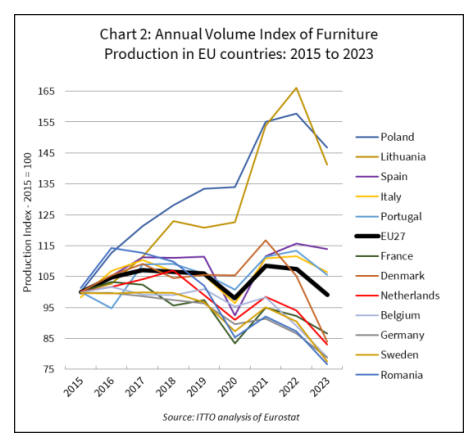
The European furniture industry is highly integrated from
both a market and an industrial perspective with most
furniture components (such as wood and wood-based
panels) being sourced from European countries. Almost
80% of furniture consumption is met by European
production. However, imports from Asian countries,
particularly China, were increasing rapidly in the years to
2021.
The long-term trend in the quantity of European wood
furniture trade as revealed by Eurostat data is shown in
Chart 3. The rise in European internal trade and in imports
from outside the region which began in 2013 as the
European economy gradually recovered from the
Sovereign Debt crisis, continued throughout the pandemic
in 2020 and accelerated in 2021.
European exports of wood furniture to countries outside
the region, which were flat in the period between 2013 and
2020, also increased in 2021. However, all these trends
reversed starting in the second half of 2022. European
imports, exports and internal trade in wood furniture
declined by 18%, 9% and 4% respectively in 2022. In
2023, imports fell a further 5%, exports were down 17%,
and internal EU trade declined 12%.
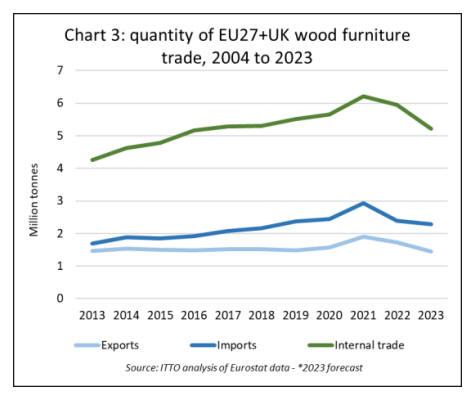
The total quantity of EU27+UK imports of wood furniture
from outside the region fell 5% to 2.28 million tonnes in
2023. This followed an 18% fall the previous year (Chart
4). The decline in imports in 2023 was less dramatic than
forecast by ITTO in October (see ITTO-MIS Volume 27
Number 19, 1-15 October 2023), primarily due to a revival
in imports from China after the COVID lockdowns in that
country ended and as freight rates fell quickly last year.
This meant that Chinese goods could again be shipped into
the European market at competitive prices, just at a time
when prices for goods manufactured in Europe were
rising.

In 2023, wood furniture imports into the EU27+UK from
China increased by 6% to 1.25 million tonnes, still well
down on the peak level of 1.51 million tonnes in 2021, but
above the pre-pandemic level.
European wood furniture imports from non-tropical
countries other than China fell 9% last year to 600,000
tonnes, following a 19% decline the previous year.
Imports from Turkey, Ukraine, and Serbia all recovered
some ground last year but not enough to offset the decline
in imports from Belarus - now subject to European
sanctions – and falling imports from Bosnia, Switzerland,
and USA.
EU27+UK imports of wood furniture from tropical
countries fell 23% last year to 430,000 tonnes, following a
9% decline in 2022 from the peak levels of 2021.
European wood furniture imports from tropical countries
were hit by a big decline in demand for outdoor furniture
last year, a sector where tropical furniture still dominates.
The reemergence of China as a major force in European
wood furniture supply in 2023 also contributed to the
sharp decline in tropical countries share of European
imports (Chart 5).
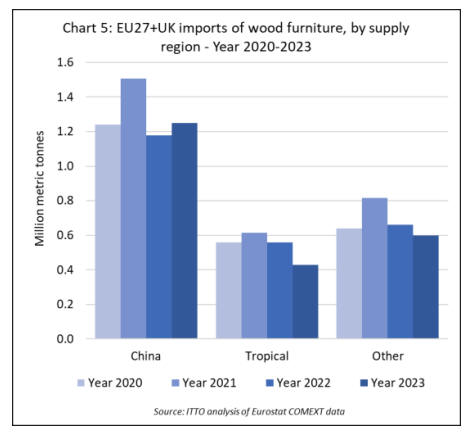
Imports from all tropical countries supplying wood
furniture to the EU27+UK declined very sharply last year
including Vietnam (-28% to 148,900 tonnes), India (-20%
to 73,400 tonnes), Indonesia (-23% to 73,400 tonnes),
Malaysia (-15% to 72,800 tonnes), Brazil (-15% to 48,300
tonnes), Thailand (-19% to 5,400 tonnes) and Singapore (-
74% to 2,900 tonnes) (Chart 6).
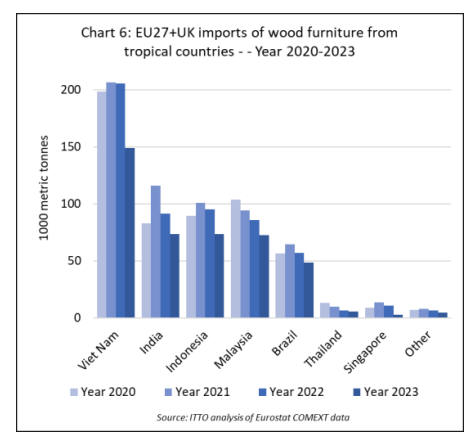
There was a big fall in tropical wood furniture imports into
the UK, the largest European market, in 2023, down 22%
to 138,700 tonnes. Large declines were also recorded by
France (-22% to 72,000 tonnes), Germany (-33% to
52,600 tonnes), Netherlands (-24% to 44,300 tonnes),
Belgium (-34% to 23,200 tonnes), Ireland (-23% to 10,700
tonnes), Denmark (-26% to 10,500 tonnes), Italy (-26% to
9,100 tonnes), and Poland (-27% to 8,900 tonnes).
Of all large European markets, only in Spain did imports
hold up well in 2023, rising 3% to 28,100 tonnes (Chart
7).
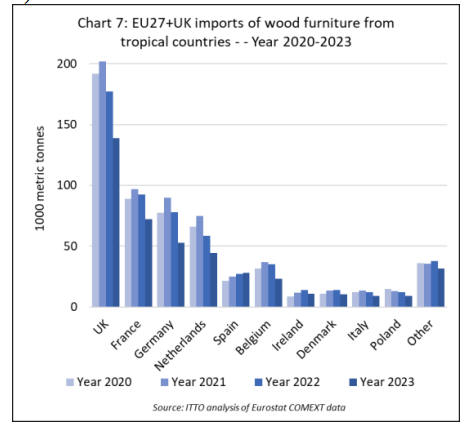
CSIL forecast gradual recovery in European furniture
market demand
According to CSIL, the Italy-based furniture industry
research organisation in their latest quarterly issue of
World Furniture Online (www.worldfurnitureonline.com),
this year prospects are slowly improving for the European
wood furniture sector. The major challenges that have
recently weighed heavily on the European furniture
industry, such as price increases and supply chain
disruptions, appear to be easing. Furniture demand is
expected to gradually improve in the second quarter of
2024 and to recover in 2025.
Based on interviews with European furniture companies,
CSIL also identify key recent changes in the structure and
strategies of the sector. Most furniture manufacturers
surveyed by CSIL in 2023 said they were increasingly
shortening supply chains by becoming more local (at
country or regional level). Within Europe, Portugal, Italy,
and Spain were identified as the main beneficiaries of this
perspective.
The relocation is driven by various reasons, including
shortening time to market. However, business
sustainability, liquidity and security of supply have
emerged as key issues that are intensified by international
events.
The implementation of the EU Deforestation Regulation
(EUDR), due from 31st December this year, which
imposes strict wood traceability requirements, is another
factor that might intensify the trend towards shortening
supply chains in the future.
CSIL’s analysis of the structure of the European furniture
industry highlights that the sector is still predominantly
made up of small and medium-sized enterprises (SMEs).
The sector employs a significant number of people, with
more than 1 million workers in over 135,000
manufacturing companies. While the industry remains
SME-based, both manufacturing and retailing are
becoming increasingly concentrated.
According to CSIL, the top 100 European companies
generate more than 30% of the total value of furniture
produced in Europe, an increasing share compared to 10
years ago. On the distribution side, the top 15 EU furniture
retailers also account for almost 30% of the market.
CSIL comment that over the past few years, from 2019 to
2023, there have been many strategic mergers and
acquisitions (M&A) in the European furniture
manufacturing sector. According to CSIL “this has
highlighted the dynamic and evolving nature of the
industry, with companies strategically positioning
themselves to strengthen their market position and
leverage synergies.
Furthermore, the M&A landscape within the European
furniture industry shows a predominant focus on local
transactions with the vast majority of total deals being
acquired by companies within the region”.
EU and Côte d’Ivoire sign FLEGT VPA agreement
On 19 February 2024, the European Commission and Côte
d’Ivoire signed their Forest Law Enforcement,
Governance and Trade (FLEGT) Voluntary Partnership
Agreement (VPA), a major step on the way to sustainable,
legal forestry.
According to FERN, an EU based NGO, the VPA “marks
more than 10 years of multistakeholder negotiation and
technical preparation to promote the trade of legal timber
between Côte d’Ivoire and the EU, a long and arduous
process that has been saluted as a model of
multistakeholder participation”.
FERN note that “civil society organisations, private sector
representatives and traditional chiefs have consistently
been included in VPA discussions, a practice that has
proved a great advantage in the implementation of many
forestry reforms over past years”.
As for existing EU VPAs with other tropical timber
producing countries, the VPA with Côte d’Ivoire is a
legally binding trade agreement designed to ensure that all
timber and timber products destined for the EU market
from Côte d’Ivoire comply with Ivorian laws and also that
the forestry sector contributes to the social, environmental
and economic development of the country.
FERN comments in relation to the VPA with Côte d’Ivoire
that “more challenges remain, naturally, as the
transformation that FLEGT VPAs drive is vast, going
beyond trade to include transparency, land rights reform
and civil society participation, among other things”. With
signing of the VPA, efforts around practical
implementation will now intensify in the country.
FERN also note that many questions arise concerning the
VPAs’ interface with the fast-approaching entry into force
of the EUDR with FERN noting that “the incoming,
stricter EUDR has led many to doubt the relevance of the
FLEGT VPA”.
Countering this perception, FERN quote Bakary Traoré,
Director of the Ivorian NGO Initiative pour le
développement communautaire et la conservation de la
forêt (IDEF) and long-time participant in the VPA
process:
“No, the EUDR does not render FLEGT totally obsolete.
Admittedly, it is diminished because it is mentioned only
as an element that ‘complements’ the EUDR in ‘specific
cases’.
In practice, however, I remain convinced that, for the
moment, no technical tools on a par with FLEGT are
available to the competent European authorities to prove
the legality of timber in the context of due diligence. And
it is a relevant tool that would do the trick. Provided we
maintain the negotiation phase’s momentum.”
|